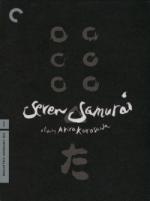Shichinin no samurai
 Year:
Year: 1954
Film Studio: Toho Company
Genre: Action, Adventure, Drama
Length: 207 Min.
DirectorAkira Kurosawa (1910)
WritingAkira Kurosawa (1910)...Screenwriter
Shinobu Hashimoto (1918)...Screenwriter
Hideo Oguni (1904)...Screenwriter
ProducerSôjirô Motoki
CinematographerAsakazu Nakai (1901)
MusicFumio Hayasaka (1914)...Composer
StarsToshirô Mifune (1920) as Kikuchiyo
Takashi Shimura (1905) as Kanbê Shimada
Keiko Tsushima (1926) as Shino
Yukiko Shimazaki (1931) as Rikichi's Wife
Kamatari Fujiwara (1905) as Manzô - Father of Shino
Daisuke Katô (1910) as Shichirôji
Isao Kimura (1923) as Katsushirô Okamoto
Minoru Chiaki (1917) as Heihachi Hayashida
Review Throughout the course of mankind's history, certain artistic endeavors have met with such critical acclaim that they stand as crowning achievements in their respected fields of culture. Michelangelo's
Pieta, DaVinci's
Mona Lisa, Beethoven's
9th Symphony and Tolstoy's
War and Peace are all considered the pinnacle upon which all subsequent works would be judged. In the world of Cinema, two celebrated films have been at the core of a debate as to which is the greatest film of all time; Orson Welles’
Citizen Kane and Akira Kurosawa’s
Shichinin no samurai. Although it’s a technical and cinematic masterpiece,
Citizen Kane has one glaring fault that keeps it, in my eyes, from being classified as the zenith in all of film history. The main characters behavior is disturbing and reprehensible, while the storyline is cold and caustic, leaving the viewer with no desire to view the film repeatedly. Kurosawa’s
Seven Samurai is the complete opposite to this profile and strikes every emotional chord with a velvet hammer, never too hard, never too soft. In the beginning we empathize with the farmer’s plight, at the mid-point we agonize with the samurai over the stacked odds against their success in the impending battle, and in the end we cheer their victory over the evil, loathsome bandits.
Clocking in at three hours and twenty-six minutes, this epic film proves that in the hands of a gifted artist, time is no constraint. Kurosawa moves from character development, to introducing a couple of key sub-plots, and finally to a glorious climactic battle with an ease and grace that had heretofore never been seen on film. Upon reaching the end of this exhilarating ride, the viewer is left with one ardent desire, to sit back and repeat the journey. I myself have jumped on this roller coaster close to fifty times, and still have not tired of the excitement. Every scene is essential to the overall structure and pacing of the story, nothing tedious or superfluous. When this film was given its original international release in 1956, Toho Studios decided to scale back the running time from 206 to 160 minutes, cleaving over 45 precious minutes. The end result could best be described by quoting a character from another favorite film of mine,
Amadeus. When he recounts the genius of Mozart's composing, Antonio Salieri states;
"Displace one note and there would be diminishment, displace one phrase, and the structure would fall". Devoid of the sub-plots and character development, the film becomes just an action picture that begins to take on the resemblance of the American remake,
The Magnificent Seven, a great film in its own right, but one that fails to reach the strata of its predecessor.
This would also be a turning point in the careers of Toshirô Mifune & Takashi Shimura. After
Shichinin no samurai, Mifune's star would rise to a level in Japan, equivalent to that of John Wayne in the United States. In that same year he would be cast in Hiroshi Inagaki's
Miyamoto Musashi, the first part of a trilogy based upon the popular novel that has been described as the Japanese
Gone with the Wind. He would be the lead in every Kurosawa film for the next 11 years, until a dispute would sever the most successful pairing of director and actor in film history in 1965. Shimura, on the other hand, would be relegated to supporting character roles in subsequent films by Kurosawa and would make his final appearance in Kurosawa’s comeback film
Kagemusha in 1980. He would pass away in 1982 leaving behind a trio of memorable performances in the early Kurosawa masterpieces. His versatility as an actor would forever be immortalized on screen as the woodchopper in
Rashômon, Watanabe in
Ikiru, and as Kambei (the samurai leader) in
Shichinin no samurai. The differences in personality and the diversity between these three characters prove that, with all due respect to Toshirô Mifune, Takashi Shimura was the more multifaceted actor.
Ratings Criterion5 Stars - The pinnacle of film perfection and excellence.4 ½ Stars - Not quite an immortal film, yet a masterpiece in its own right.
4 Stars - Historically important film, considered a classic.
3 ½ Stars - An entertaining film that’s fun or engaging to watch.
3 Stars – A good film that’s worth a Netflix venture.
2 ½ Stars - Borderline viewable.
2 Stars – A bad film that may have a moment of interest.
1 ½ Stars – Insipid, trite and sophomoric, and that's its good points.
1 Star – A film so vacuous, it will suck 2 hours from the remainder of your life.
½ Star - A gangrenous and festering pustule in the chronicles of celluloid.